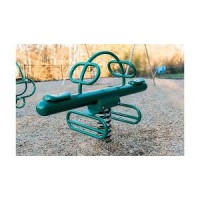See Saw and Teeter Totter

Public Playground Safety Handbook - CPSC Publication 325
U.S. Consumer Product Safety Commission
5.3.5 Seesaws
5.3.5.1 Fulcrum seesaws
The typical seesaw (also known as a “teeter totter”) consists of a board or pole with a seat at each end supported at the center by a fulcrum. See Figure 16. Because of the complex way children are required to cooperate and combine their actions, fulcrum seesaws are not recommended for toddlers or preschool-age children.
• The fulcrum should not present a crush hazard.
• Partial car tires, or some other shock-absorbing material, should be embedded in the ground underneath the seats, or secured on the underside of the seats. This will help prevent limbs from being crushed between the seat and the ground, as well as cushion the impact.
• The maximum attainable angle between a line connecting the seats and the horizontal is 25°.
• There should not be any footrests.
5.3.5.2 Spring-centered seesaws
Preschool-age children are capable of using spring-centered seesaws because the centering device prevents abrupt contact with the ground if one child dismounts suddenly. Spring-centered seesaws also have the advantage of not requiring two children to coordinate their actions in order to play safely. Spring-centered seesaws should follow the recommendations for spring rockers including the use of footrests(§5.3.7).
5.3.5.3 Use zone for fulcrum and spring-centered seesaws
• The use zone should extend a minimum of 6 feet from each outside edge of the seesaw.
• The use zone may overlap with neighboring equipment if the other piece of equipment allows overlapping use zones and
– There is at least 6 feet between equipment when adjacent designated play surfaces are no more than 30 inches high; or
– There is at least 9 feet between equipment when adjacent designated play surfaces are more than 30 inches high.
5.3.5.4 Handholds
• Handholds should be provided at each seating position for gripping with both hands and should not turn when grasped.
• Handholds should not protrude beyond the sides of the seat.
5.3.5.5 Fall height
The fall height for a seesaw is the distance between the highest point any part of the seesaw can reach and the protective surfacing beneath it.
